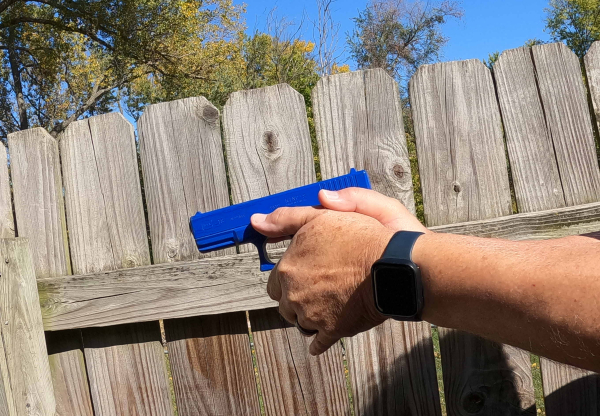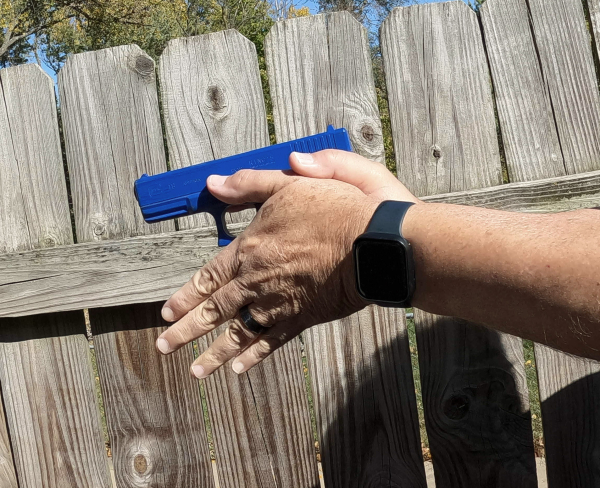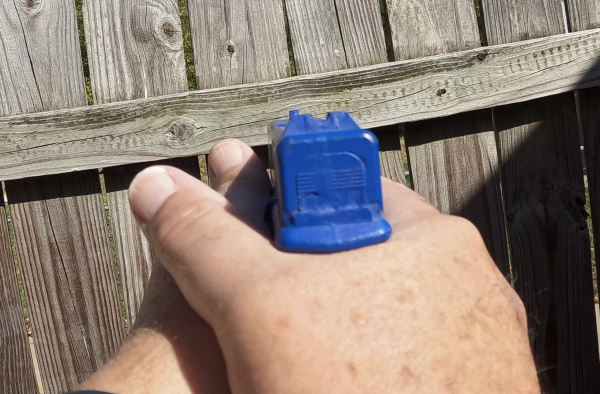
Recently, I had an issue with point of aim/point of impact on a number of guns. I recalled that some years back, I had a student who simply could not point the pistol at the target. At best effort, the muzzle always pointed off to shooter’s right/target’s left.
We removed the pistol slide and I had the student look through the sights at my eye. There was no problem in using sights, it was the way the arms-wrists-gun felt vis-à-vis the target. I asked Vince O’Neill, expert trainer in physical skills and student of “physical intelligence,” for his take on the issue. What follows is my edit of that exchange.
To start out with, we have to ensure the grip is right. Is the web of the strong hand crushed up under the tang? The strong hand middle finger crushed up against the junction of the trigger guard/frame, with all other fingers seamlessly lined up underneath?
The primary hand thumb has to be up in the air to make room for the support hand’s “drumstick.” The trigger finger needs to be 90° across the bow of the trigger shoe to eliminate as much finger vs. frame/trigger friction as possible.


The support hand needs to be as seamless as the primary hand. The index finger of the support hand must be crushed up under the trigger guard with the support side wrist locked down. To test for this, have the shooter unfold the fingers of the left hand after taking the two-hand grip. If the fingers point forward, you have a weak, no-bone-support grip; if they’re pointing down, the grip is right.
Have the shooter flex the support arm to the side just slightly. In fact, it might be a good idea to have the left elbow just a little higher than the right. While it’s counterintuitive, the shooter has to be over the gun as well as behind the gun. This is where to sort out eye dominance issues.
As far as stance, check that the feet are wider than the knees and knees wider than the hips, listing forward, nose over toes. The balance should be on the balls of the feet, digging the toes into the ground to hold oneself up. The brain needs to be balanced over the spine, the chin thrust down and out so as to get the retinas 90 degrees relative to the sights — emmetropic (good) vision is all-important here.
Ensure that the zero is consistent. We’re referring to the distance from the rear sight to the front of the eye ball. Remember that our arms act like two beams supported at only one end. When you shorten the beams, either by cantilevering or pulling the arms inward toward the center in order to support the weight of the gun, the zero changes. Recoil and follow-through characteristic change, too. I don’t care if you do have natural point of aim, the bullets ain’t going where you want them to go because you’ve changed your follow-through.

There are no cures but here are things to try to find the center. Using the grip, have that left thumb running along the top of the frame even if it lightly touches the slide. The left thumb can index onto a target and line the sights up just by pointing. We do it every day. Every time we shake hands, for instance, we aim and index our thumbs onto the target — a friend’s hand, also indexed onto our own hands. This is about as close to instinctive shooting as you’re going to get.
Try this: With a dummy gun (or one unloaded with a flagged chamber), point your thumbs with pistol in hand. Just point, no sight picture, just point. Pick out something on the wall. Now, hold the gun still as if breaking a shot, then move your eyes behind the sights. You shouldn’t be off your target but a hair, if not perfectly on it.
O’Neill follows with a cautionary note, something to be considered for anyone in firearms training – or any physical skills training.
Injuries to the left hemisphere can produce selective impairment. Neurologists call it, apraxia, i.e., individuals who are physically capable of carrying out a set of motor sequences, and cognitively capable of understanding directions, are, nonetheless, unable to do so in proper order or in the proper manner.
The operative word in the former and latter is “proper.” Apraxias are more common than you might think. The most common is limbic apraxia, where an individual, for instance, can’t carry out a command with either hand … (there’s) ideomotor apraxia, where an individual clumsily executes actions by use of the body part itself as an object (like when you say “Hammer it,” they’ll use their fist to form a hammer rather than mimic the actual grasping of a hammer’s handle with commensurate movements to imitate use of a hammer…if that makes sense).
Ideational apraxia is where shooters exhibit difficulty (a special difficulty) in running through a sequence of movements smoothly and in correct order. In other words, “they can’t put it together.” That said, “normal” individuals tend to display some form of apraxia because of external, or self-imposed pressure to perform. Yet, when the shooter “voluntarily” performs a sequence, all is perfect.
So stress plays a big part in learning psychomotor skills. It also plays a huge part in failing to learn psychomotor skills. Some of it is behavior, some of it is physical, and/or a combination of both. Alas, physical education isn’t a high priority nowadays. The priority, on the other hand, of firearms–where we live–suffers for it.

